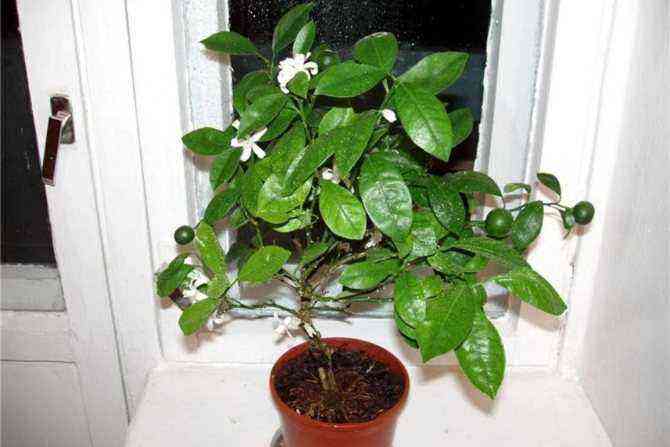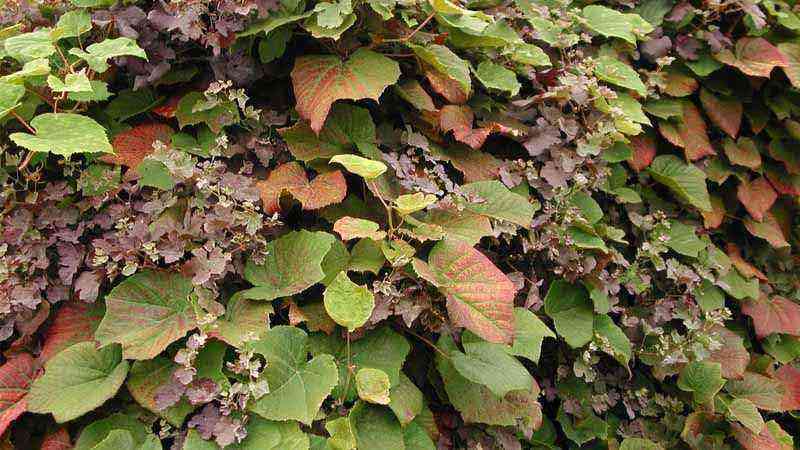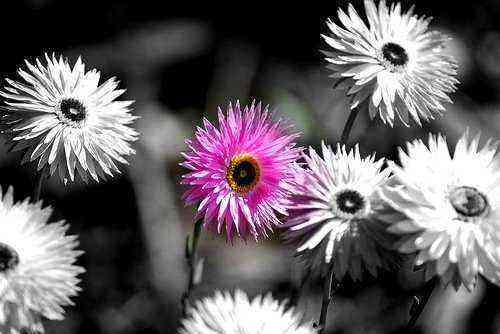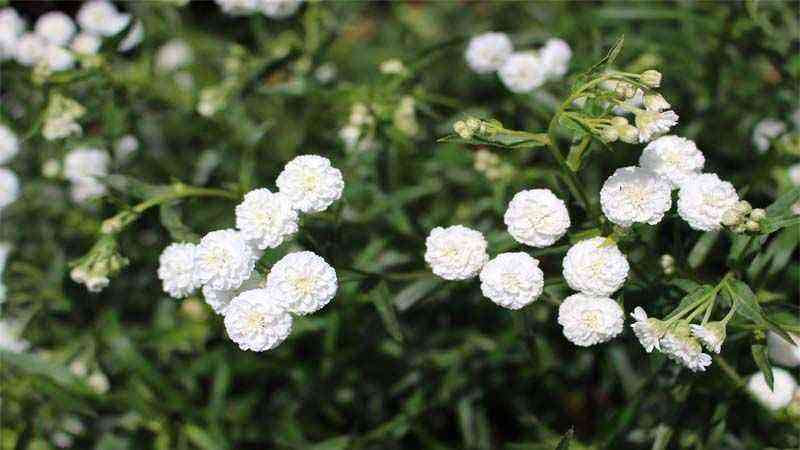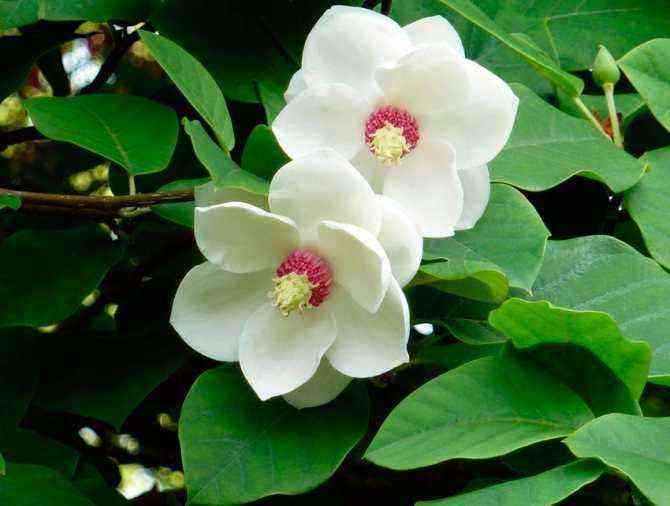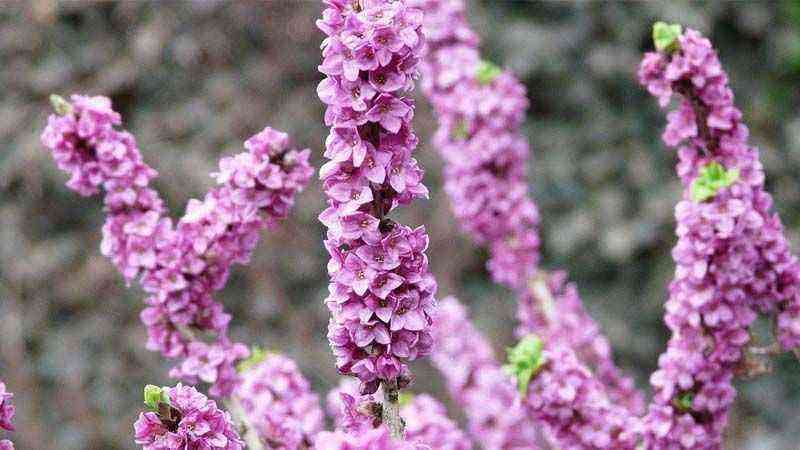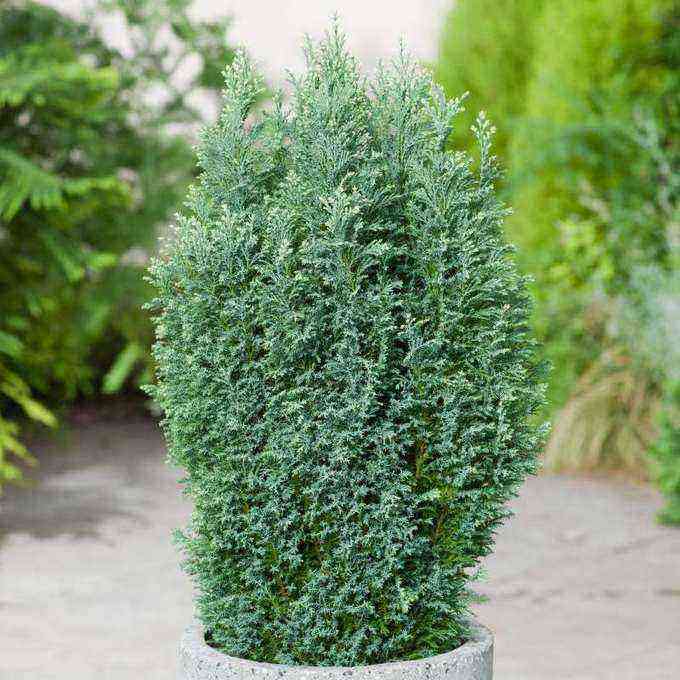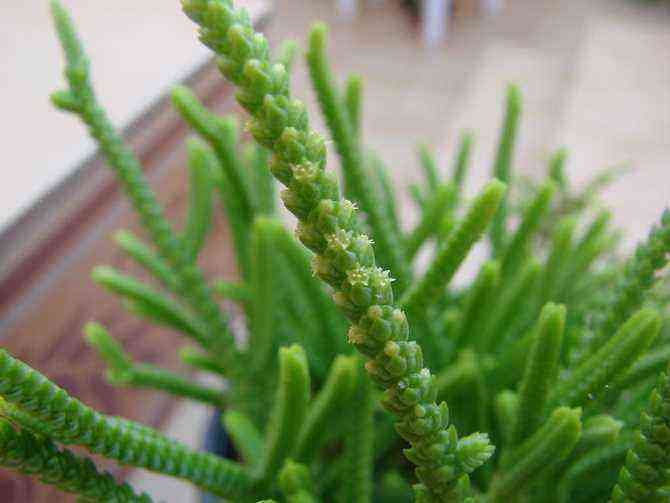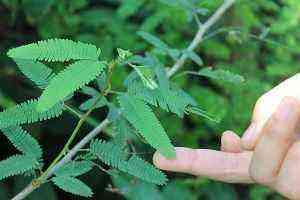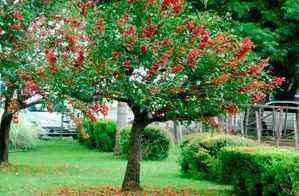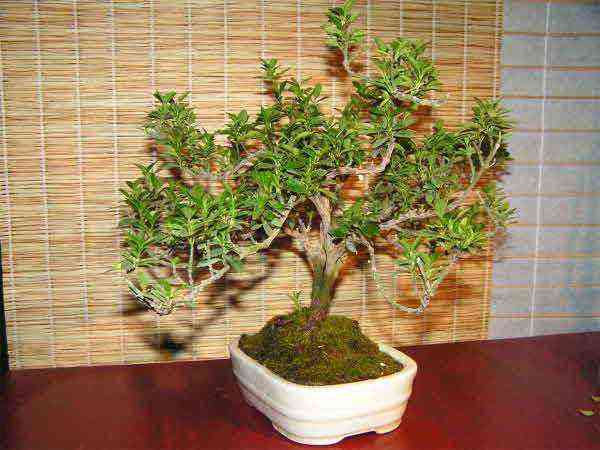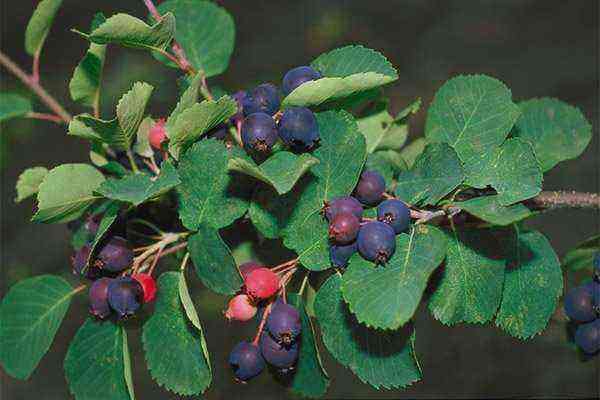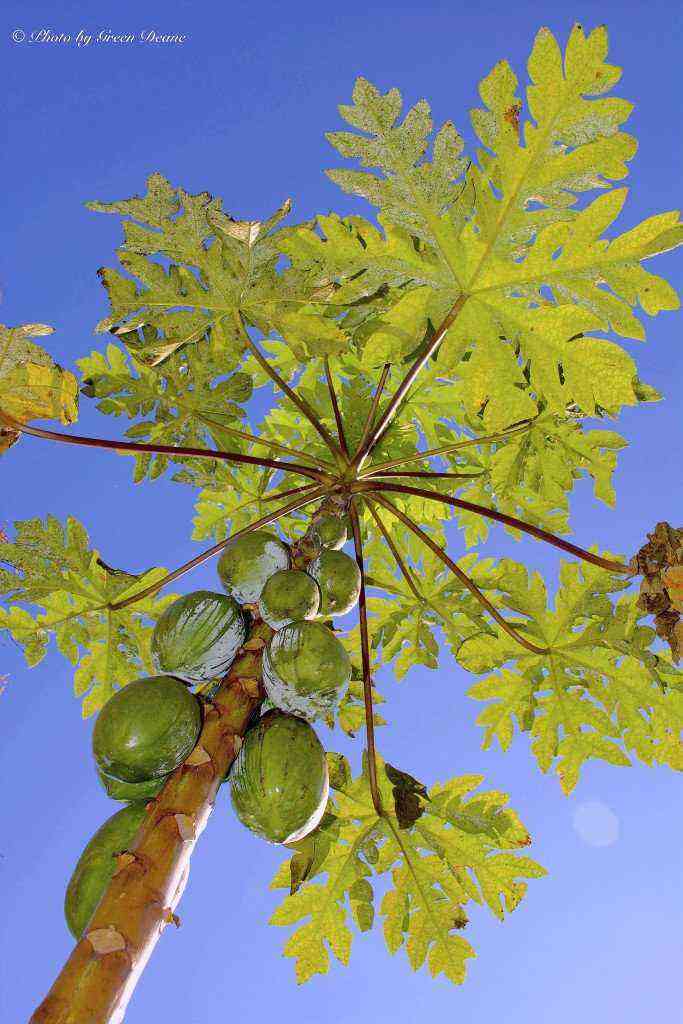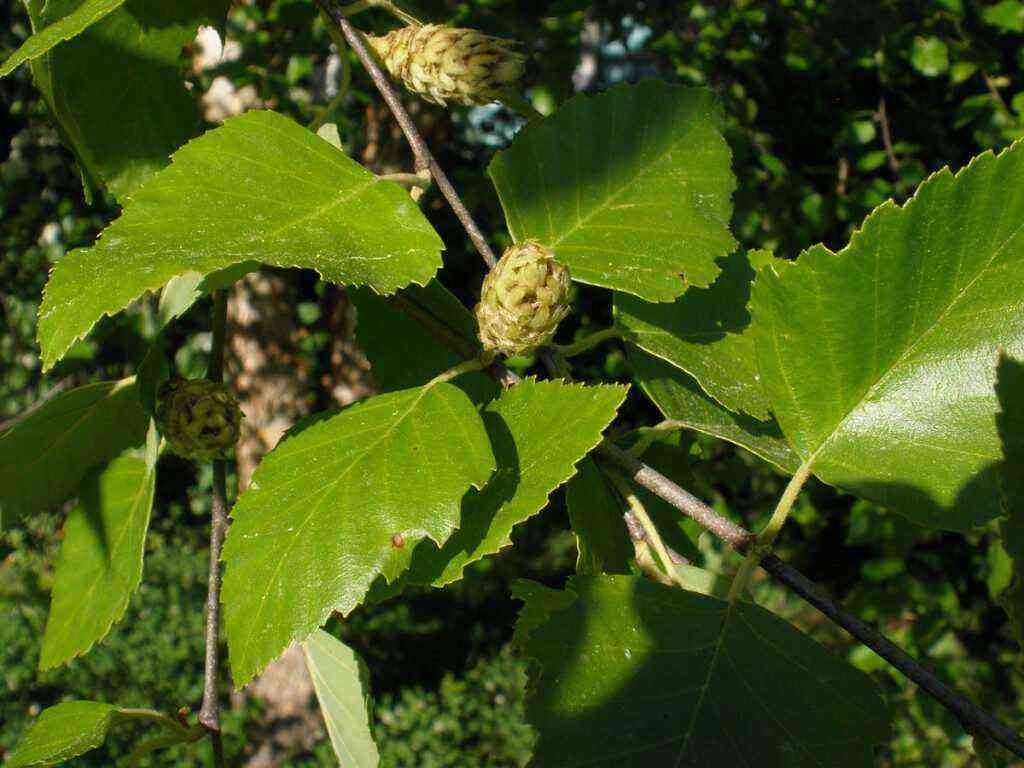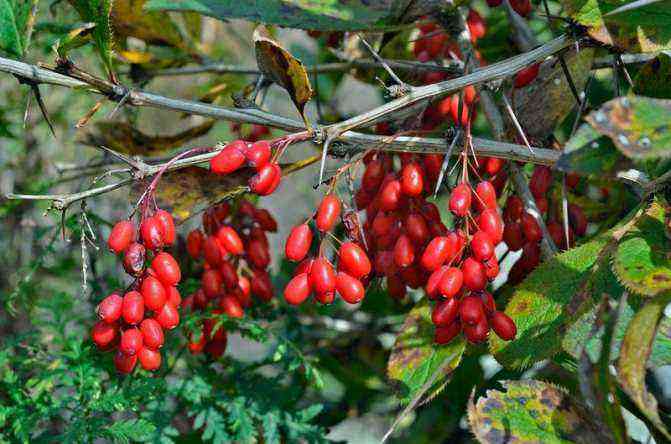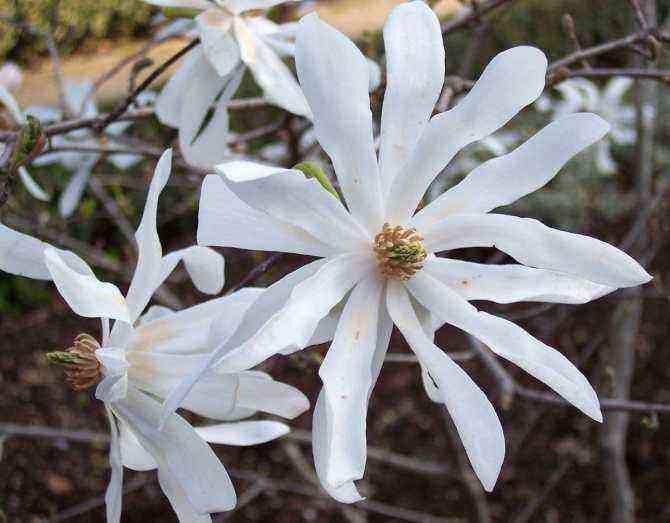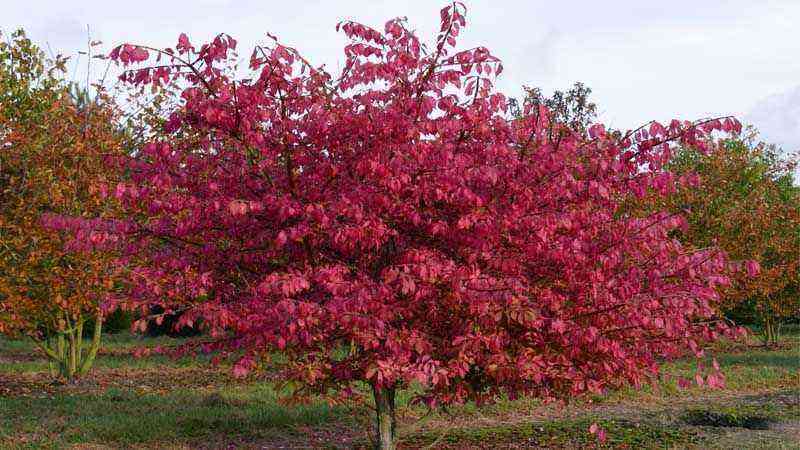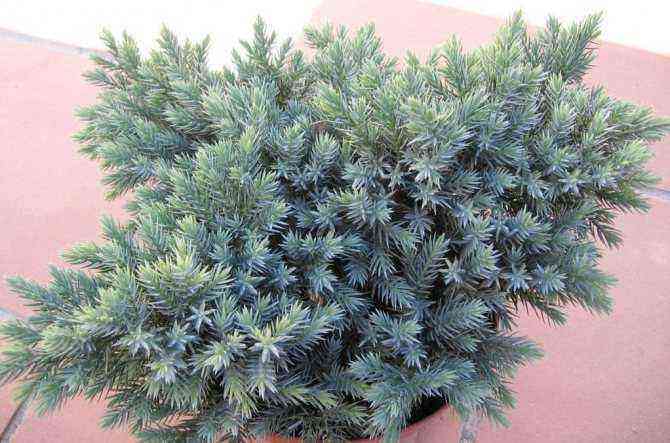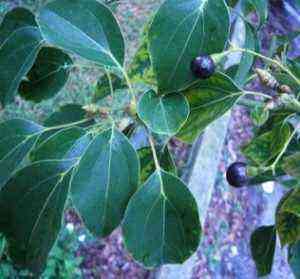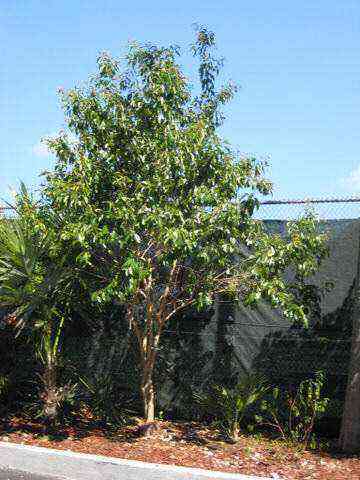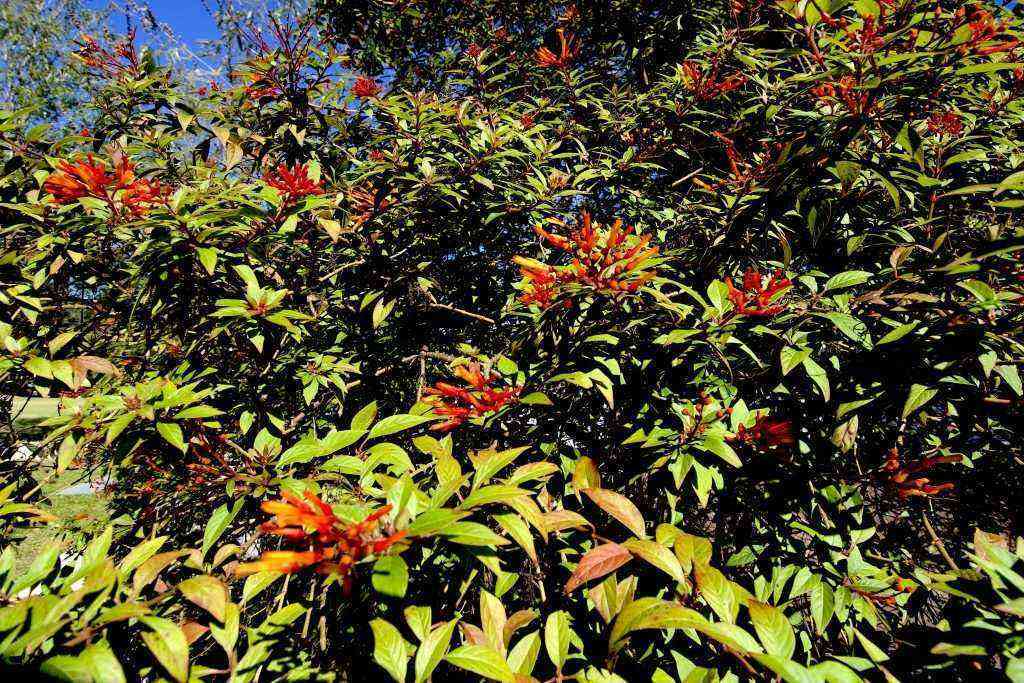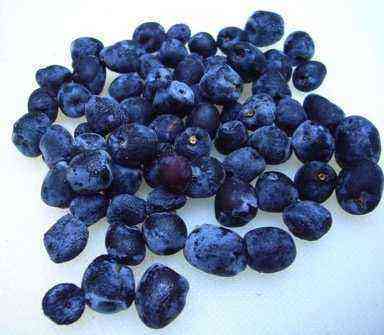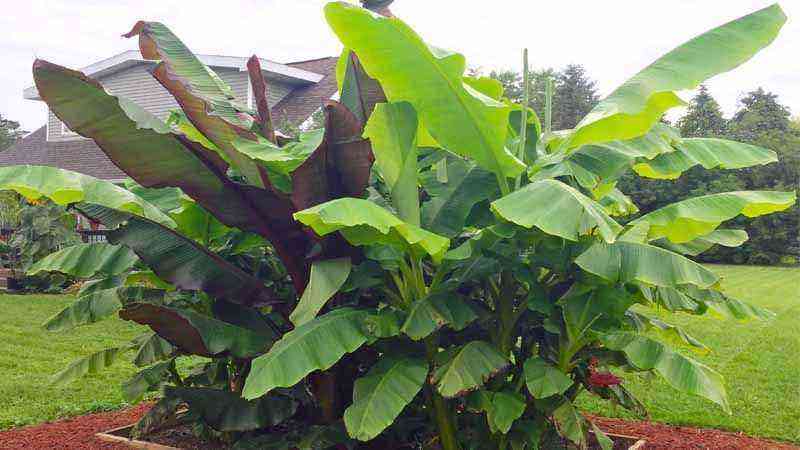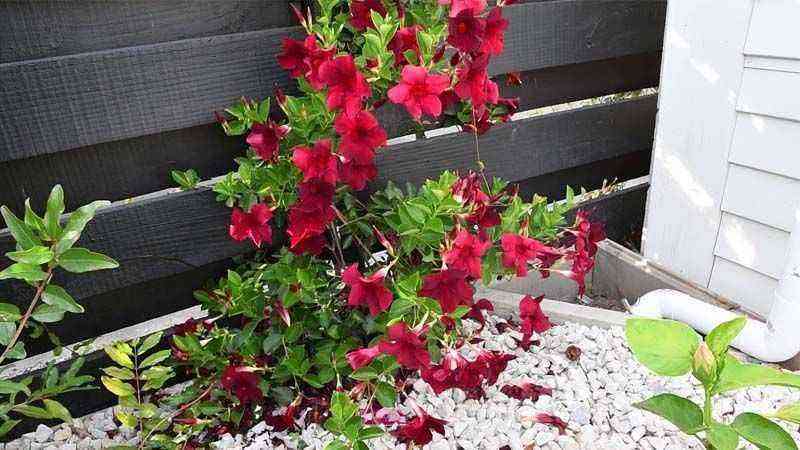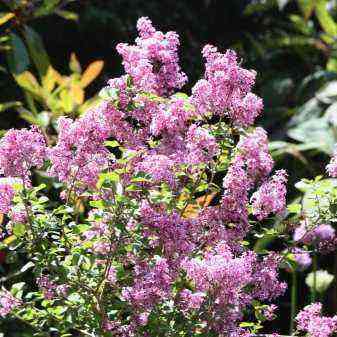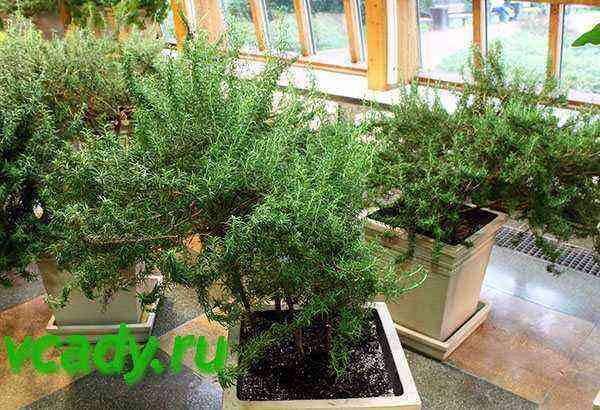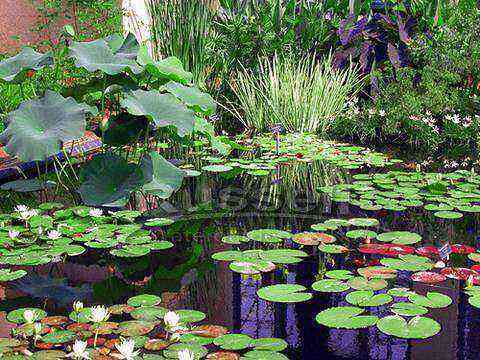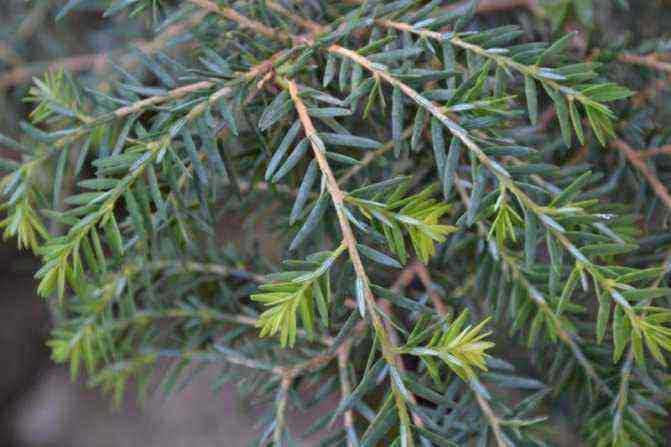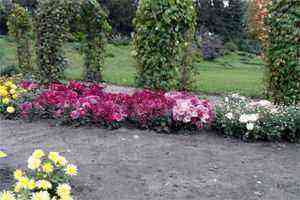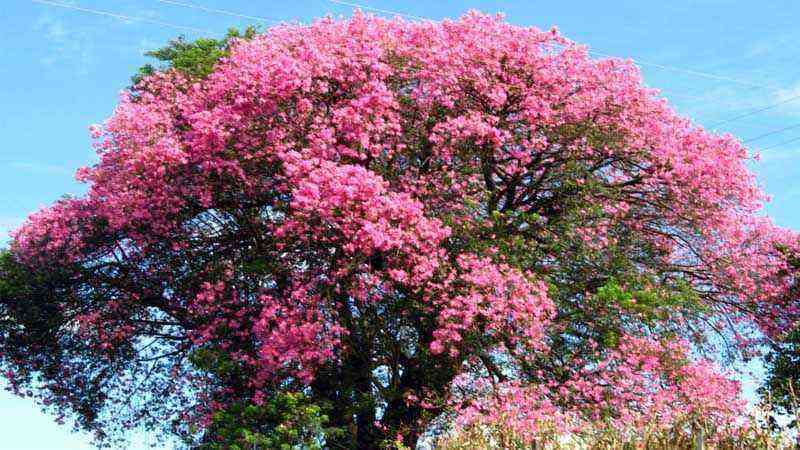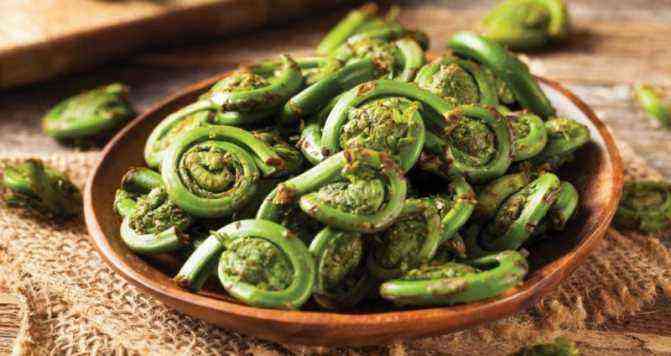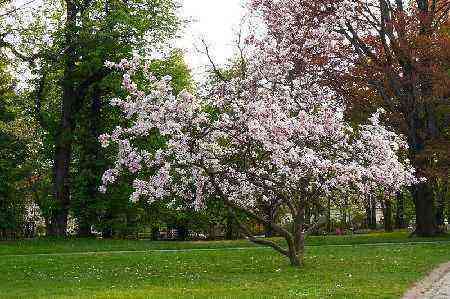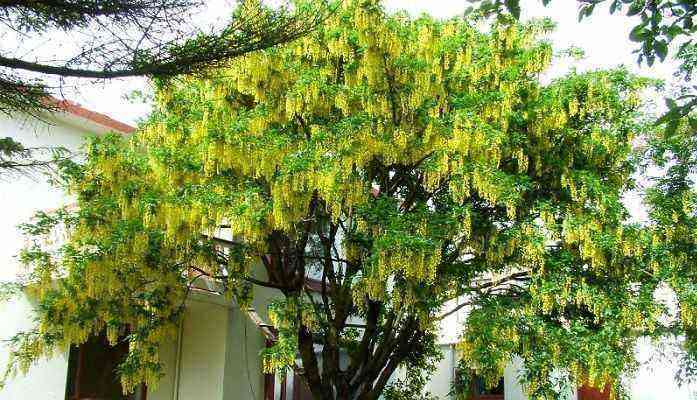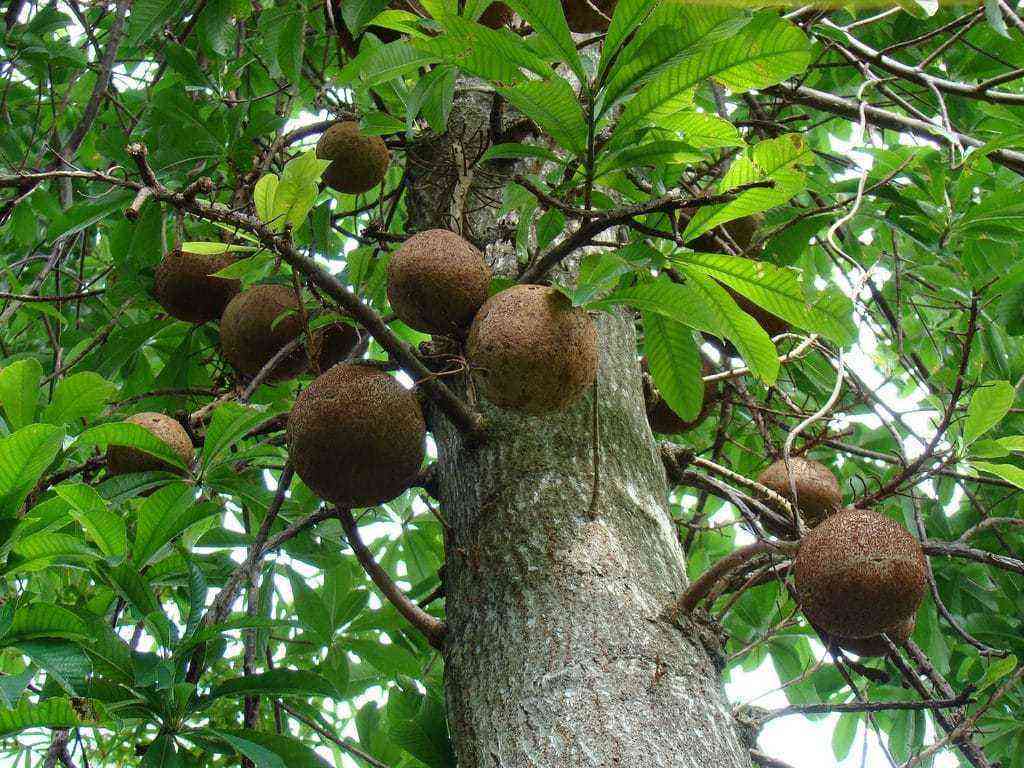There is a good omen to plant these shrubs next to the house. According to her, a person will be protected from troubles and will attract happiness to himself. It is better to plant this ephedra in front of the house, and not behind it.
Juniper and thuja belong to the same cypress family.
Description of the similarities and differences between thuja and juniper:
- The similarities are in the same scale-like needles.
- The differences are in the shape of the bumps.
- The juniper has a spherical cone. It looks very original.
- Thuja has cones of an oval elongated shape.
Juniper looks great on any site. The main thing is to choose the right variety for the size of the plot. Next, you need to follow a number of recommendations on how to plant it on the site.
When is it better to plant?
They are planted in open ground in spring, autumn and even summer. You just need to follow certain rules on how to plant a juniper.
- Spring landing… Early spring (March, April) is the best time to purchase a seedling and plant it on your site. The main thing is not to wait for strong warming and an increase in air temperature. It is better to tackle this issue immediately after the snow melts. During this period, the most chances are that the plant will take root and take root well.
- Autumn planting. You can plant junipers in a permanent place in the fall. As soon as the heat subsides and the rainy season comes, it is a good time to plant junipers in your area. Minus autumn planting – the plant may not have time to take root, take root before the onset of cold weather and soil frosts.
- Summer landing. In the summer, plants that have already taken root are planted on the site. Such seedlings are purchased in pots or burlap.
Thus, you can plant junipers almost all year round. It is allowed to purchase planting material already with berries, which are formed in the second year of the juniper’s life. In addition, it is frost-resistant, withstands frosts down to -30.
Due to this property, the shrub is used in landscape design in any climatic region of Russia: the middle lane, the Moscow region, in Siberia and the Urals.
How to fertilize correctly
When fertilizing a shrub, it is necessary to take into account a number of subtleties associated with its care.
- The optimal time for the first treatment is from early spring (April) to June. The need for additional fertilization is judged by the speed of development of the cypress. During the season, it is allowed to carry out several dressings, maintaining an interval of 4-5 weeks between them.
- Preference should be given to products with a low nitrogen content, especially if they are supposed to be used in the autumn. This chemical element can burn the roots and provoke active growth of shoots and freezing due to the fact that they do not have time to stiffen before the onset of winter.
- The drugs must be used according to the instructions, without deviating from the recommended rate.
- Granular products are evenly distributed at a distance of 10 cm from the trunk of the juniper, only slightly deepening into the soil.
- The effectiveness of fertilizers increases if they are preceded by abundant watering.
Choosing a landing place
How to plant juniper in the country?
You need to choose the right place for the seedling:
- Sun… An open area well lit by the sun is the best place to plant junipers in the ground. On such a site, this ephedra will delight with a lush, dense crown, good growth and bright color of the needles.
- Penumbra… It is permissible to plant junipers in light partial shade, which is given by other trees in the garden. There are many varieties that will do well in these conditions. These are such varieties as: Green Carpet, Sentinel Cold, Cone Columnaris.
- Тень… This shrub should not be placed in full shade. In such a place, the crown of the juniper will become loose, translucent. It will lose its decorative appearance. In addition, varieties with a bluish, bluish, combined color (Old Gold, Icee Blue, Donai Blue, Golden Carpet) will change the color of the needles over time to the usual green color.
So, choosing the right place on the site where to plant junipers, you will create optimal conditions for good development of the shrub, growth and maintenance of the color of the needles.
Soil preparation
For transshipment of juniper to a permanent place, a special soil mixture is prepared:
- Sour soil mixture.They take in equal proportions high-moor peat, compost from rotted fallen leaves and mowed grass, river sand. All components are purchased in specialized stores. The soil mixture will be obtained with an acidic medium, with a ph of 4,5 – 5,5. This environment is essential for most conifers.
- Alkaline soil mixture… Good growth requires an alkaline soil mixture. For this, slaked lime or dolomite flour is added to the soil, observing the application rates. Cossack and Central Asian juniper varieties – lovers of alkaline soil.
As you can see, there is nothing difficult when preparing the desired soil mixture.
How to Avoid Common Feeding Mistakes
When choosing fertilizers for feeding a juniper, it is necessary to take into account a number of important points that can lead to serious mistakes in the care of coniferous shrubs:
- Useful substances must be selected based on the composition of the soil, as well as on the requirements of a particular culture. The wrong choice of top dressing is fraught with a change in the level of acidity of the soil, which will certainly affect the condition of the plants.
- Compliance with the recommended dosages when applying fertilizers is vital, since an excessive concentration of active substances can lead to burns of the plant root system.
- It is important to follow a certain sequence of fertilization procedures, as well as the necessary intervals between them. Otherwise, an excess of one or another element is formed in the soil, which negatively affects the quality of the soil and the condition of the plants.
Juniper is an ornamental evergreen plant. It grows in any soil, depending on the variety: some need an alkaline environment, others prefer acidic soils. Before buying a seedling, you need to clarify the information about which variety is better to plant on the site in order to take root.
The plant adapts well to local conditions, does not require special care. But the main task of the gardener is to keep the needles green and lush. It is by the appearance of the greens that they determine how suitable the conditions are for the juniper.
The rules of agricultural technology for conifers are similar in many ways: they all love sprinkling irrigation, but do not tolerate stagnant moisture in the soil. Top dressing of adult plants is rarely carried out, young plants need more nutrients, therefore, for the first 3 to 4 years, they are fertilized several times per season.
How to choose a planting material?
Seedlings in pots
This is the best option for planting material:
- It is better to purchase plants in small pots, up to 5 liters in volume.
- They are easier to remove from containers without damaging the juniper root system.
- In addition, such bushes take root faster and take less time to acclimatize.
Branch or stalk
For this breeding method in the spring choose an escape of the last year with a length of 10-15 cm. Further, the needles are removed from it. After that, the cutting is planted in a prepared peat pot.
At the first watering, a root formation stimulator is added to the water. Root, heteroauxin, clonex gel are used. Complete drying out of the substrate is not allowed. After 15-2 months, a branch is planted in a permanent place.
It is best to buy and use ready-made juniper seedlings with a closed root system. Such planting material is easier to plant in open ground.
Landing technology
Quick step-by-step guide:
- Prepare a planting hole for the plant. The size of the hole should be 2 times larger than the earthen lump with the roots of the seedling.
- Pour drainage into the bottom of the pit. Fired clay (expanded clay) is suitable for this, the layer is at least 20 cm.
- Transfer the juniper to the planting hole. Spread out the roots carefully without damaging them. The root collar of the seedling should be at ground level. Do not deepen the plant more than it should be.
- Fill up the voids around the seedling. To do this, use a mixture prepared in advance of high moor peat, sand, compost. Then lightly tamp the soil.
- Water the ground around the planted plant. It will be useful to use fertilizer for better rooting of the seedling. For example, Kornevin is used every two weeks for two to three months.
- Mulch the soil… After planting a juniper, the soil around it is covered with pine bark or chips. A layer of mulch must be made at least 10 cm. This technique will reduce the frequency of watering in the summer, additionally acidify the plant, and protect the roots of the seedling from freezing in the cold season. Additional protection is the key to good development of the juniper for the next year.
Conifers on a trunk can also be used as planting material. How to plant such junipers? They are planted in the same way as regular plants. The nuance is that when planting in the ground, the place of the scion near the root stem is located on the south side.
These are the main stages of planting a juniper in open ground. Adhering to these simple recommendations, you can independently plant the purchased shrub on your site.
Features of planting forest juniper
Often, forest, wild juniper (or, as it is also called, cypress from the forest) is used for landscaping the site. He is unpretentious in care, requires a minimum of attention.
There are several important points about how to plant a forest juniper:
- For planting wild juniper, choose a sunny place or partial shade. It grows poorly in full shade.
- It is necessary to mark with a ribbon the branch that was on the sunny side. When handling the plant, try to place the juniper in the planting pit with the same orientation to the cardinal points.
Juniper Nutrient Blends
What to fertilize juniper can be found in the garden. It can be humus that has been in the pile for 1,5 – 2 years. Fresh manure, which contains a lot of free ammonia, must not be used.
An excess of nitrogen has a bad effect on the condition of the needles. It turns yellow and dries, and with it the branches. It is advisable to add humus during planting. And do not use fertilizer for the next 3 years. Except when the ephedra grows on sandy soil.
Compost, which is used to fertilize juniper in autumn, is used every 3 years for adult plants. It is dug up with the top layer of soil above the roots. Then watered and mulched. Young trees can be compost added more often – once a year in spring to accelerate growth and green mass gain.
Video: Juniper Care
Wood ash is a popular substance that feeds junipers in the fall. It contains large amounts of potassium and phosphorus, as well as trace elements: magnesium, zinc, iron, boron, calcium. In order not to spend money on special additives, once a year it is necessary to make an ash solution and water the bush. 300 g of the substance is added to a bucket of water and insisted. In this form, the fertilizer is absorbed faster. Ash has an alkaline reaction and reduces acidity in the area where juniper is planted.
To replenish humus reserves, green manure is used. They are put into a barrel and filled with water. When they begin to ferment, the soil is watered with the resulting liquid, and the plant residues are spread around the bushes, covering them with a layer of bark on top. This is necessary to create shading.
Soil bacteria process organic matter in the dark, and under the rays of the sun, microorganisms die. Mulch prevents drying of the topsoil and weathering of nutrients.
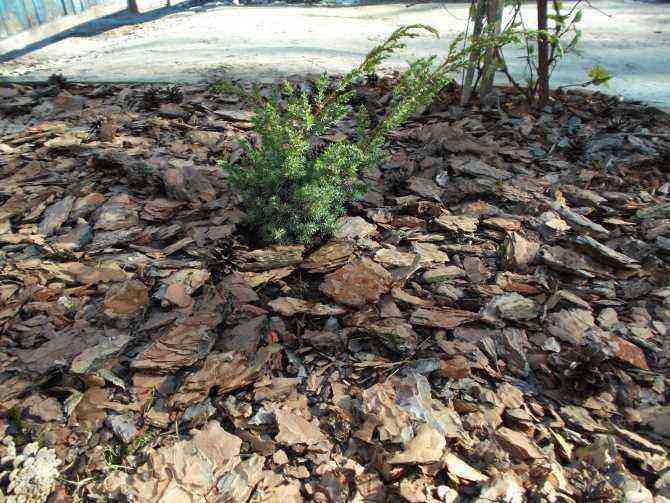
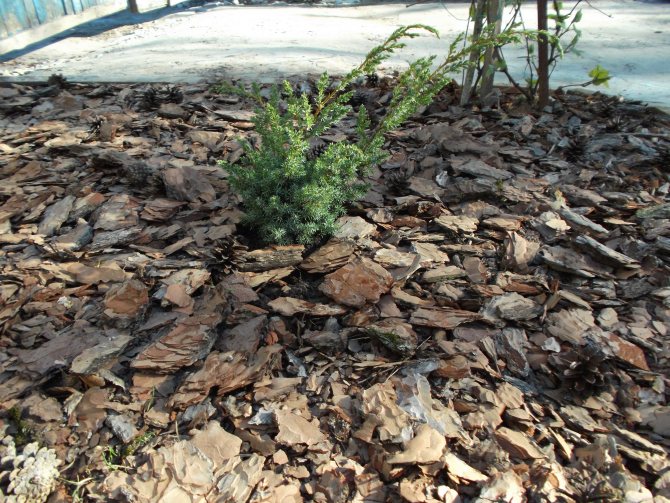
Juniper planting schemes on the site
There are many schemes for how to beautifully plant junipers of different varieties and types. Consider the basic planting schemes and figure out which plants are best for grouping conifers:
- Group plantings of different varieties. This arrangement of junipers will look great in front of the facade of the house. In this case, different varieties of vertical, horizontal, creeping junipers are selected. In the center, you need to place the tallest and most powerful plants, and at the edges – low, ground cover.

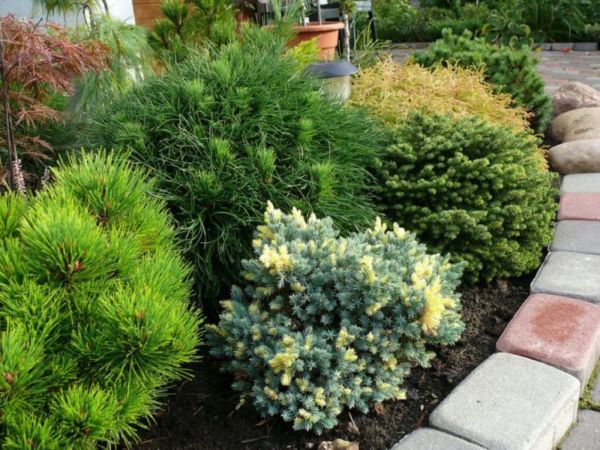
- Group plantings of the same variety. Treelike varieties of tall, large junipers can be used here. This planting is suitable for creating hedges. Suitable varieties are Virginian juniper, Chinese, rocky.

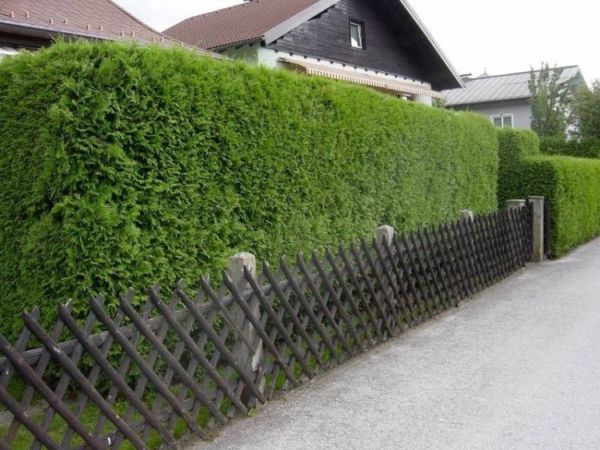
- In a group with roses and other perennial flowers and plants. Combining junipers with flowers such as roses, irises or peonies can create an interesting composition. Only in this case it is better to use flowers of the same shade. Junipers next to red-leaved barberry or heather will look organic and stylish. The latter, like juniper, belongs to acid-loving plants. Accordingly, they need the same care. This design can be applied inside a vegetable garden or flower garden.
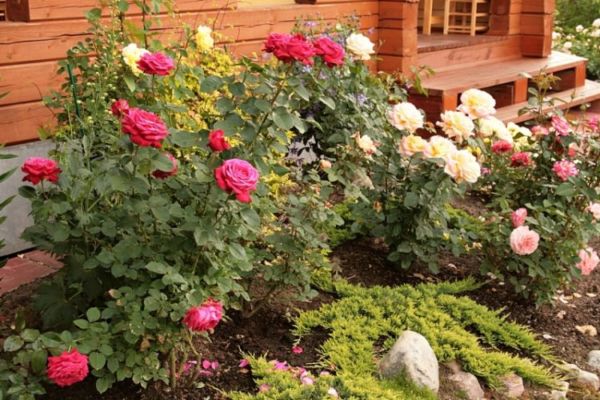
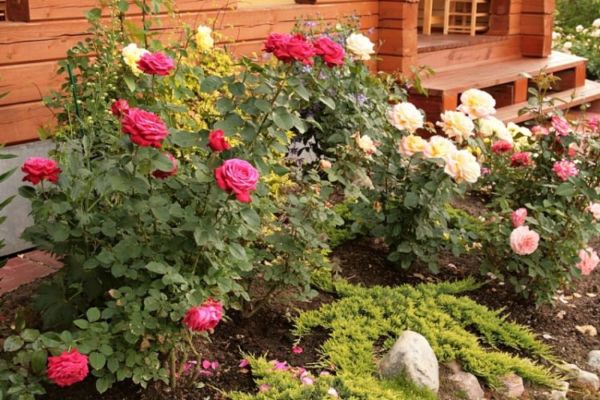
- Neighborhood with trees and shrubs such as apple, pear, hawthorn, quince. Choose a garden location for any juniper, away from the listed fruit trees. They are carriers of the rust fungus, to which this representative of conifers is very susceptible. In general, it is not recommended to plant any ephedra near these seedlings.


When using any juniper planting design, try to plant some distance away, not very close to each other. As they grow, many varieties increase in size dozens of times. And the root system also develops.
A thickened planting of junipers will contribute to the development of fungal diseases and the appearance of harmful insects.
Juniper as a hedge
Some types of juniper can be planted around the perimeter of the site, and they will serve you as a fence that protects both from the wind and from prying eyes. Also, with a proper location, with the help of such a hedge, you can divide the garden, vegetable garden and flower garden, equip a recreation area. Especially refined aesthetes even manage to erect a kind of curbs from junipers.
Care after planting in the garden
It often happens that the juniper turns yellow after planting. This phenomenon means that the bush has not yet taken root and it is difficult for planting in open ground. In this case, in addition to watering, fertilizers are used for the root system.
And it is also advisable to spray the needles with growth stimulants, which will help relieve stress after transplanting and return the needles to a healthy look. These can be drugs Zircon, Epine, Stimulus, Radipharm.
Watering and top dressing
Juniper is a drought-resistant ephedra that requires a minimum of attention and care.
But like any living plant, it needs watering and fertilization:
- in hot summer you need to provide watering at the root at least once every two weeks;
- Junipers are fed every 1-1,5 months;
- use a complex fertilizer for conifers containing nitrogen, potassium, phosphorus and trace elements;
- the amount of fertilizer applied is calculated according to the instructions.
Transfer
If the juniper needs to be transplanted to another place on the site, then this is best done in early spring. Without waiting for the soil to be completely thawed, they begin to transplant the plant.
How to plant:
- prepare a new planting pit;
- carefully dig up the juniper with a clod of earth without damaging the roots;
- transfer the seedling to its place;
- fill the remaining empty space with the prepared peat mixture. It will be possible to water and fertilize the juniper a little later, when the air temperature is above zero.
Adult, large shrubs are recommended to be planted in a new place only if absolutely necessary. Since there is a high probability of damaging long roots when digging. In addition, such trees and shrubs take root hard, they often get sick and lose their decorative appearance.
Trimming
Juniper is one of those plants that do not need regular pruning… But at the same time, he tolerates a haircut normally. Therefore, you can, if desired, independently form the shape of the crown.
Below are a few highlights when pruning your shrub:
- Juniper is cut all spring and even at the beginning of summer.
- Use a pruning shear or lopper with sharp blades. Using such a tool, the cut will be even and the tree will more easily transfer pruning.
- Do not cut too many branches and shoots at a time.as the juniper can get sick and even die after pruning.
- Regular removal of dry and damaged branches is imperative. They interfere with the normal development of healthy shoots. Such branches do not add attractiveness to the appearance of the juniper.
- After pruning, it is recommended to treat it with copper sulphate and cover the cut points of large and thick branches with garden pitch. Melt the garden pitch in a water bath before work, then it is easier to use a brush.
Diseases
Like any plant, juniper can be susceptible to fungal diseases.
The main causes of the appearance of diseases:
- Excess or lack of moisture… With improper watering, the needles first turn yellow, and then die off. In this case, you just need to adjust the watering.
- Accumulation of salts in the soil… This happens when pets (dogs, cats) go to the toilet under the seedling. The needles become dirty orange in color and dry out. It is necessary to stop this action, otherwise the bush may die. For support, the seedling is treated with Epin or Zircon on the needles.
- Attack of various fungi… They can appear on your site from neighbors or together with a new plant. Fungal spores are easily spread by the wind.
Common causative agents of coniferous diseases:
If any disease is found, start treatment immediately. From every fungus there are fungicides to which these spores are susceptible.
The drugs Fundazol, Topsin, Tilt, Rovral will help to cope with fungal diseases. These fungicides are sprayed on needles in dry, calm weather in the morning or evening. The treatment must be repeated after ten days.
vermin
There are many insects that harm the juniper.
Let’s consider the main ones:
Pest control measures:
- Collecting nests and larvae by hand with a small number of insects.
- Spraying with insecticides and acaricides of plants in case of mass lesions in summer. These are the drugs Engio, Calypso, Aktara, Confidor, Decis, Iskra. Preventive treatment against pests of junipers in spring and autumn is recommended.
- Digging of near-trunk circles in autumn and spring, as a result of which the pupae of insects are destroyed.
Feeding rule
Fertilizers are applied in the spring. When reproduction is carried out by cuttings or a prepared seedling is planted, then fertilization of the earth occurs every year in spring. In summer, this is done when the plant grows poorly due to a lack of nutrients.
If you know some points, then you can see if the plant has enough of this or that microelement:
- if the needles turn yellow, then this is a clear sign of a lack of magnesium;
- violation of the shape of the leaves, or their death, is a sign of a large amount of nitrogen.
The plant cannot grow without fertilization. You need to know what kind of soil the juniper prefers. If you take into account all these rules, then there is an opportunity to grow a healthy coniferous plant, with beautiful needles.


Juniper care in autumn
Rules for caring for junipers in the fall:
- Autumn complex processing junipers from pests and diseases. Used insect preparations such as Calypso, Confidor, Envidor, Engio, Aktara. As a fungicide, you can apply Fundazol, Topsin, Thanos, Skor. Shrubs should be treated with a protective mask.
- Top dressing with complex autumn fertilizer with a minimum nitrogen (N) content for ephedra. There are granular fertilizers for dry application and water-soluble fertilizers.
- Abundant watering around the trunk to saturate the roots with moisture before winter.
By following these simple guidelines, you will strengthen the juniper before winter.
Preparation for winter
- Thermal insulation… Before winter, it is recommended to cover young and recently transplanted conifers with a special covering material with a density of at least 50 microns. This will protect the seedlings from frost and spring sunburn.
- Bandaging branches… Adult junipers with a spreading crown do not need to be insulated. It is advisable to tie them with jute twine, connecting several large branches to each other. So, you will prevent branches from breaking under the weight of the snow.
Such simple actions will help the plant survive the winter well. And already in the spring there will be good growth.
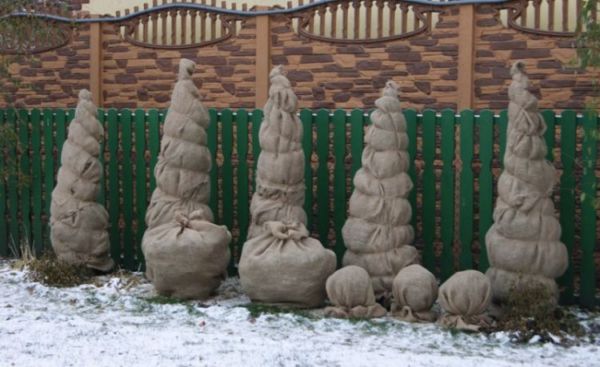

Warming juniper for the winter
How to prepare top dressing yourself
Mulch
Mulching is a great way to enrich the soil. You can use special purchased mixtures for it, as well as straw, tree bark, coniferous needles. The material is distributed in the area of the trunk circle so that it reaches 10 cm in thickness. After wintering, the mulch should be moved away from the base of the shrub to avoid decay.
The benefits of mulching include:
- maintaining the required level of soil acidity;
- the development of favorable microflora in the soil, which contributes to plant nutrition;
- mulch acts as an obstacle to the appearance of weeds, which delay the nutrition of the juniper;
- prevention of rapid weathering and leaching of useful elements from the substrate.
Compost
Overripe compost is an excellent top dressing for cypress trees. The technique of use is similar to mulching – a 10-centimeter layer is formed under the plant, only dry grass is used as a material in most cases.
Reproduction of juniper
Having an adult juniper bush available, it can be propagated. There are several main ways to do this. It must be said that bush and woody forms reproduce by seeds and green cuttings, and creeping junipers – by layering.
Cutting
This is the most common way of dividing all conifers. The best time of the year for cuttings is spring.
Consider the main stages of grafting:
- Planting material it is better not to select and cut off in the scorching sun. Since the sun’s rays additionally injure the adult bush after pruning.
- Opt for crown breeding semi-lignified shoots.
- Cut the twig with a sharp blade. You need to grab the twig along with the so-called heel. This is a piece of old bark where the twig attaches to the main shoot.
- Needles are removed from prepared cuttings and immediately planted in a substrate (a mixture of high-moor peat and river sand in a 1: 1 ratio).
- Water the soil with water with the rooting agent, which will contribute to the appearance of roots.
- Containers with cuttings are placed in a greenhouse with optimal climatic conditions (high humidity and air temperature, diffused light).
- You can leave the established cuttings in a greenhouse for a whole year. Here they will get stronger and grow up.
Cultivation from seeds
The most difficult and painstaking way.
You will have to act in several stages:
- First, the seed is cold treated.
- In addition, the seeds of some varieties are very dense and will be difficult to germinate. Therefore, it is advisable to scarify them, that is, to damage their shell.
- After that, the seeds are planted in the prepared substrate. Care for seedlings is simple: water the soil as it dries, cover young seedlings from the sun’s rays.
- After a couple of years, the seedlings are transplanted into open ground along with a lump of earth.
Reproduction by layers
The method is possible for creeping juniper varieties. It consists in the fact that the branches are not cut off from the seedling, but bent to the soil. This procedure is carried out in any growing season (spring, summer and early autumn).
Let’s consider how to proceed:
- Pick the youngest twigs on the bush. Shoots from last year will not work, they will take a very long time to root.
- Prepare the soil around the plant. Dig it up, loosen it up. It will be useful to add high-moor peat and sand.
- From the selected branches, you need to remove the needles 10 -20 cm from the start of the shoot.
- Bend the sprouts with the prepared side to the ground and fix with pegs or hairpins.
- Water and loosen the soil around the cuttings as needed.
So, choosing any of the breeding methods, you will need to make an effort. The main thing is not to lose sight of the main points in this matter (remember about watering, airing). As a result, you will get a new, independent tree or shrub grown with your own hands.
Juniper feeding – in spring, summer and autumn
Juniper belongs to the genus of cypress evergreens. They are quite unpretentious to the soil and do not require careful maintenance. But in order for the juniper to grow healthy and pleasing to the eye, it is still necessary to perform a number of procedures.
Care of the plant
In order to provide favorable conditions for the growth and development of juniper, special rules for caring for it must be observed. Required:
- Watering. Juniper does not require a lot of water. Even in hot weather, one watering per month is enough. It is recommended to give the plant a “shower” once a week by spraying water on it. It is best to do this in the early morning or late evening to prevent damage to wet needles by active sunlight;
- Pruning. In addition to the systematic removal of dead branches, the plant does not need pruning. If you wish, you can give an individual shape to the bush, but this should be done carefully, without stopping many branches at a time, since the plant can get sick;
- Winter and spring care. In order to prevent freezing (if the juniper grows in cold regions), the juniper is covered with a cloth, and the young seedlings are sprinkled with sawdust or straw. If the plant did not cover for the winter, then this must be done at the beginning of spring, when the intensity of solar activity increases. This will help prevent the risk of sunburn, after which it is difficult to recover. After the snow melts, the plant is freed from the covering material, then it is carefully examined, the protective mulch is removed around the trunk – this will help protect the root trunk and roots from decay.
Note! Another important component of juniper care is top dressing. This is a necessary procedure, especially for transplanted, young plants, since they are still weak and susceptible to all kinds of diseases.
It is also necessary to carry out top dressing if the soil at the planting site is poor. This process must be performed throughout the season. Feeding should be started one month after planting, adding nutrients in small amounts.
Soil requirements
Before planting a juniper, you need to carefully study the composition of the soil on the site. This is due to the fact that each type of plant has an individual need for soil.
For example, Cossack, Central Asian and ordinary junipers require an alkaline soil for a favorable life. For other species, an acidic environment is more suitable.
To create it, add peat, sand or mulch using sawdust or wood shavings. Dolomite flour or slaked lime is used to create an alkaline environment.
It is also important to create natural air exchange (aeration) for the root system. For this, drainage must be introduced: broken brick, river pebbles, large expanded clay.
There is a recipe for preparing a universal soil composition suitable for all types. It is necessary to mix peat, river sand and soil from coniferous forest in proportions 1: 1: 1. It is imperative to carry out mulching with wood chips or peat, sprinkling them near the base of the trunk.
Important! After planting any type of juniper, it is watered with a large volume of water. Then, for protection purposes, mulching is carried out around the trunk of the plant. The material is pine nut shells, peat, sawdust, pine bark, crushed cones. The thickness of the pillow varies from 5 to 10 cm.
Fertilizers and fertilizing
While the juniper bush is still young, it requires annual fertilization. It is allowed to start fertilizing the plant only in the second year after planting. If this is an adult representative of cypress, then it is necessary to feed it once every 1-2 years. Superphosphate, rotted manure, ammonium nitrate and other mineral fertilizers can act as a fertilizing material.
The most optimal time for the introduction of nutrients is from late April to early June (the period of swelling of the kidneys). Fertilizers should be applied to the ground around the plant, retreating 15 cm from the trunk, to a depth of 10 cm. After applying top dressing, water the plant with water.
In the summer, it is necessary to feed the juniper with special compounds and substances useful for coniferous representatives. They must contain the following elements:
- copper;
- manganese;
- iron;
- potassium;
- phosphorus;
- zinc.
Such elements enrich the juniper with the necessary substances that have a beneficial effect on the color saturation of the needles, strengthen the plant’s immunity and increase resistance to weather conditions.
When choosing a fertilizer for feeding shrubs in the autumn, preference should be given to mixtures in which nitrogen is present in minimal quantities.
This is due to the fact that this component reduces the ability of juniper to tolerate low temperatures. This is due to the active growth of shoots, which do not have time to stiffen before the onset of cold weather, as a result of which they freeze out.
The plant also needs magnesium at this time of year to prevent the top from turning yellow.
Juniper favorably perceives organic, liquid fertilizers based on vermicompost dissolved in water. Such feeding is able to stimulate root growth and also activates photosynthesis.
Conclusion
Proper care of the juniper will help not only to extend the life of the plant, but also to preserve its natural beauty, which will delight the owner for many years. An integral part of caring for this shrub is the introduction of fertilizers into the soil, which strengthen the plant’s immunity and its root system, and ensure its healthy appearance.
Source:
Features of planting and care at home
If you wish, you can plant junipers in the apartment. In this case grow conifers in the bonsai style. Using this style, miniature trees and shrubs are acquired, exact copies of large garden species. The most suitable varieties of junipers for bonsai are Daursky, Cossack, Virginsky.
Choose the most lighted windowsill or balcony. By the way, it will be possible to take the plant out to the balcony or other cool place for the winter. The temperature for winter maintenance is not higher than +10. In winter, it is necessary to reduce watering to once a month.
Caring for indoor juniper is no different from caring for garden species. And also watering is needed as the earthen coma dries, regular inspection for the absence of pests and diseases, the introduction of complex fertilizers for conifers. In addition, it is desirable to spray the crown from a spray bottle.
How to feed juniper
Juniper is a fairly unpretentious crop that does not require much effort to care for it. It does not need constant feeding and can grow successfully in rather unfavorable conditions. However, when growing a juniper in the garden, it does not hurt to feed it occasionally to ensure even development and a consistently healthy and attractive appearance of this evergreen plant. It is enough to apply fertilizers twice during the season so that the coniferous shrub receives all the nutrients necessary for its growth. This article will discuss how to feed a juniper and how to do it correctly.
What varieties of juniper to plant in the country?
There are a huge number of species and varieties of junipers. What to plant on your site, you decide for yourself or seek advice from a landscape designer. In this case, the main thing is to correctly correlate the size of the site and the juniper after a few years. After all, small seedlings are sold, which over time can increase in size dozens of times.
Photo gallery: varieties of juniper


Coloniform

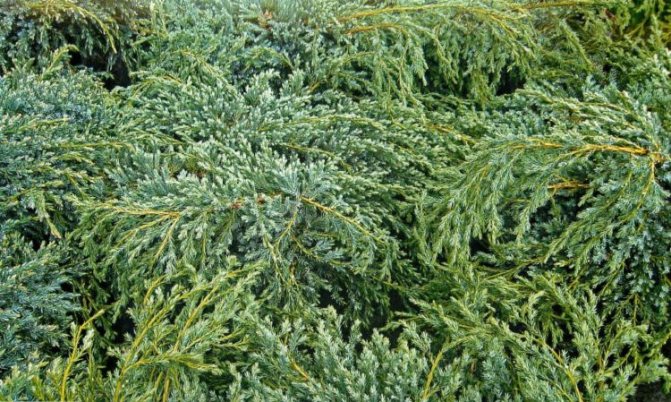
Chinese Horizontal Scaled Cossack Blue Chip

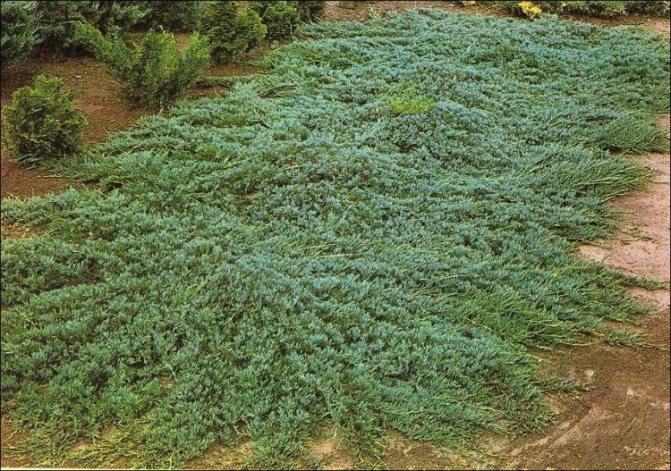
Struggling

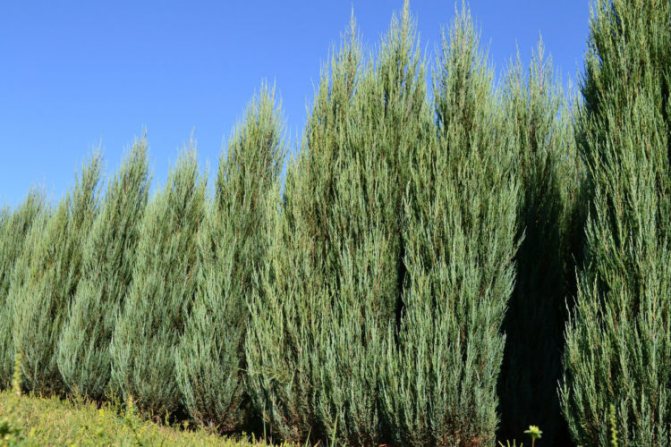
Rocky
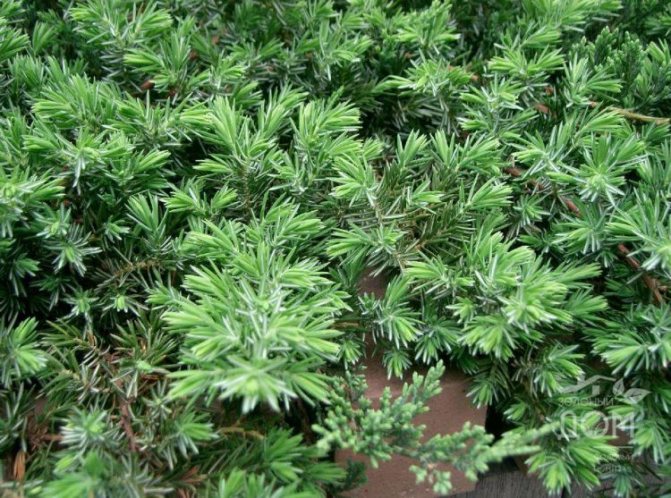

Coastal

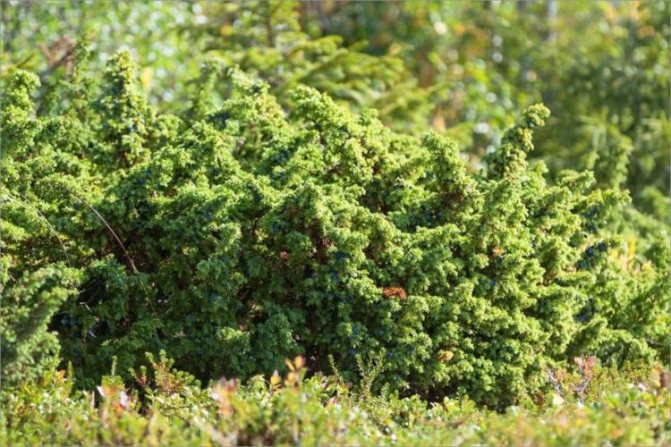
Ordinary
Rate the article:
Top dressing of an adult juniper
It is not necessary to feed an already middle-aged plant, but in order for it to have a rich and healthy color, then special feeding is used.
In hot summer and before possible frosts in autumn, juniper is given a lot of water so that it accumulates as much moisture as possible.

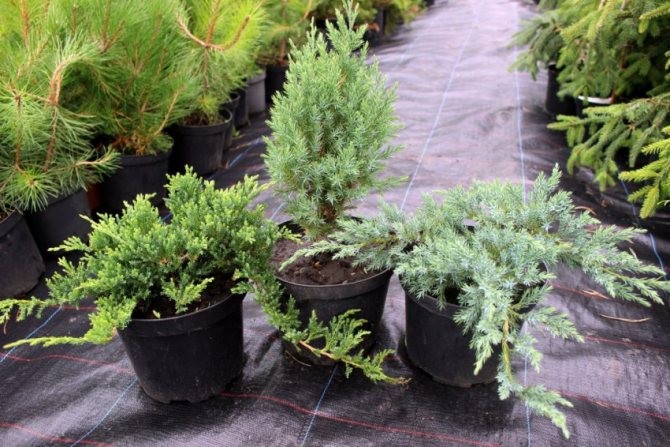
Summer residents love juniper for its aesthetic appearance and ease of care.

